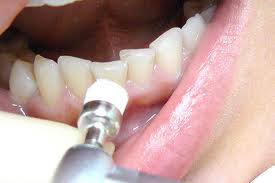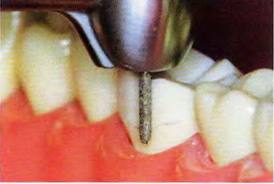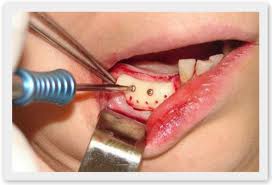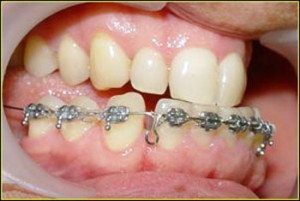Preparing teeth for prosthetics

The preparatory stage of prosthetics is important in the process of restoring the functionality of the teeth and creating a beautiful smile.
Preparation of teeth for prosthetics includes a comprehensive examination and treatment of the patient's oral cavity in order to prevent complications and achieve a positive result.
In any case, dental prosthetics begins with a consultation with the dentist, who determines the amount of preliminary preparation.
Conditionally, training can be divided into:
- Therapeutic.
- Surgical
- Orthodontic.
- Orthopedic.
Therapeutic preparation
The main areas of therapeutic preparation of the patient’s oral cavity for prosthetics are oral sanitation and tooth deculpation.
Oral Remediation
It is a mandatory procedure before prosthetics.
Its goal is to create favorable conditions for prosthetics: the elimination of foci of inflammation, both in the oral cavity and throughout the body.
Without adequate preparatory manipulations, it is not possible to achieve a successful and long-term result.
Professional toothbrushing

Plaque, which is formed from particles of food, mineral salts and mucus on the surface of the tooth, is an excellent environment for the development and reproduction of bacteria.
Therefore, it is often the cause of the development of caries, as well as the presence of halitosis.
The formed hard plaque cannot be removed on its own, and therefore, professional toothbrushing is required before prosthetics.
Removing tartar will not allow tooth decay to develop under a dental crown.
At this stage, the patient is trained in the proper care of the oral cavity, which is a guarantee of the long-term functioning of the denture after its installation.
Dental treatment
- Caries treatment, replacement of old fillings is one of the important points in ensuring high-quality dental prosthetics. Untreated caries, can lead not only to the appearance of bad breath and toothache, decreased immunity, but also to headache, malaise, allergies, etc. complications.
- Root canal filling.
- Preparing the roots for setting tabs.
Periodontal Treatment
Problems associated with periodontal disease should be resolved before prosthetics begin.
Symptoms of periodontal disease include bleeding gums, bad breath, loose teeth, and periodontal pockets.
To strengthen the loose teeth, they are splinted.
If periodontitis is not cured and its aggravation occurs after the installation of the prosthesis, then the movable teeth will not be able to hold the removable structure.
Tooth preparation
- If there is evidence, the nerve to be replaced with a tooth is removed, followed by filling the tooth canal.
- The tooth is turned under the crown.
Preparation of supporting teeth

Abutment teeth are teeth that support the dental structure. Crowns are put on them.
The supporting teeth take on not only the weight of the prosthesis, but also the entire chewing load. For this reason, the condition of the abutment teeth is of great importance when prosthetics.
Before installing the prosthesis, the abutment is prepared so that the contact between the tooth and the crown is tight enough, which in turn will not allow caries to develop under the prosthesis and will provide a more physiological distribution of the masticatory load.
Preparation of an abutment for a crown includes:
- Tooth turning.
- Depulpation is strictly according to indications.
Video: “Tartar Removal”
Surgical preparation
The surgical stage of preparation for prosthetics includes:

- Removal of dead teeth and unsuitable teeth and roots (granulomas, cysts at the apex of the root of the tooth, severe loosening of the tooth, complete destruction of the crown of the tooth, leaving deep under the gums, softening of the hard tissues of the tooth, etc.). With a stable root and the absence of signs of inflammation, it can become a good support for bridges and crowns.
- In the presence of osteophytes and exostoses that interfere with the installation of structures, they are removed.
- Removal of hypertrophied soft tissues of the gums and other parts of the mucous membrane.
- Surgery to deepen the vestibule of the oral cavity, plastic frenum (tongue, upper lip, lower lip).
- Installation of implants. It is produced both with non-removable dental prosthetics and with the purpose of creating support for removable dental structures.
- Carrying out osteoplasty (removal or extension of bone tissue, etc.).
- Sinuslifting surgery (performed on the upper jaw to raise the bottom of the maxillary sinus). It is carried out to create a place during implantation.
After appropriate surgical preparation, it takes about two months to recover before prosthetics can begin.
Orthodontic preparation
Modern orthodontic methods allow you to change the inclination and position of the teeth.
Preliminary orthodontic preparation allows you to correct:
- The position of the teeth that will represent the support for removable and non-removable dental structures.
- Forms of the dentition.
- The inclination of the teeth, in relation to the missing.
- Fan-shaped position of teeth.
- Stretching of retined (not cut, located in the bone) teeth, which can serve as a support for the denture.
- To create additional space in the oral cavity for installing a fixed or removable structure.
At the stage of preliminary orthodontic preparation, much attention is paid to secondary deformations of the teeth after the removal of both antagonistic and neighboring teeth.
Activities such as:

Mouthguards or special bite plates are made to move teeth that have advanced toward previously extracted teeth.
Provide the creation of space for the installation of the prosthesis on the opposite jaw.
The manufacture of muscle relaxants or relaxing chewing muscles of the mouth guards to prevent the destruction of dental structures after dental prosthetics.
Mouthguards can also be made for complex treatment with lowering the height of the bite, in the presence of pathology of the dentition and displacement of the temporomandibular joint from a normal position, etc.)
This preparation avoids the depulpation and grinding of deformed teeth. It can take from 2 to 3 months to 2 to 3 years.
Cost of services
| Type of service | Price, rub.) |
| Unsealing the root canal for installing the anchor pin | 500 |
| Preparation of the tooth for the installation of the stump pin tabs. | 2300 |
| Professional ultrasound teeth whitening | 2500 |
| Tooth extraction with anesthesia | 800 |
| One root canal filling | 1000 |